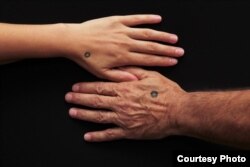The fruits of an 18-month artistic collaboration between Kurdish and Turkish youths recently went on display in the southern Turkish city of Diyarbakir.
A mixture of documentaries and photo exhibits, the BAK project — which was initiated by Anadolu Kultur, an Istanbul-based civil society organization — involved 24 young people carefully selected from 10 eastern and western Turkish cities, bringing together people divided along ethnic and regional lines.
BAK sought to bridge those divides, said Latife Ulucinar, the project's coordinator.
"People, especially young people, living in different parts of Turkey don't know each other," she said. "Face-to-face encountering is important, and we want to give some possibilities to these young people to experience the city, which they don't know, and we want them to know the culture, the habits and the casual life of these cities by living and by seeing."
The participants had to develop collaborative art projects at workshops organized in Izmir and Diyarbakir. The issues addressed included the 1923 population exchange between Greece and Turkey; Roma people; and identity, including tattoo culture. The Kurds' decades-long battle for minority rights also featured heavily in many works.
“Zilan,” a video documentary, recalls a forgotten massacre of thousands of Kurds and the exile of many more by the Turkish state in the 1930s.
"I found out that many killed were relatives of mine and the affected villages were very familiar," said co-director Derya Gumus, "I met people who survived, the last witnesses. Even though I live there, I learned it very late as well, so I wanted to tell this."
Along with making it possible to rediscover history, the project also provided the opportunity to reach out.
"There is [a] need for such a project,” Gumus said. “In order to understand each other, we have to touch each other.
"The participants from the western cities had to come to this region to overcome the prejudices that are created mostly by the media," she added. "Thanks to this project, our friends from the west overcame their prejudices. They touched us. Over and over again, we had conversations where they said, ‘We now understand you.’"
Gumus admits that collaboration was not always easy, but says that shared interests helped the process. Her collaborator was originally from the Black Sea region, but now studies in the western city of Izmir, which is one of the main hubs for refugees seeking to enter Europe.
That experience, Gumus says, helped to provide common ground.
"My partner in the project was already interested in similar subjects, especially migration,” she said. “We didn't have conflict in that sense, we communicated well. Politically, he was very close to my thinking.”
Overcoming the ethnic divide became harder when fighting between the PKK Kurdish rebel group and the Turkish government resumed, following the collapse of peace talks last July.
Diyarbakir, one of the BAK host cities, witnessed some of the worst fighting.
That resumption of fighting cut across some projects.
"The Resort of the East: Hazar" sought to show an aspect of Kurdish life rarely seen: normality.
"We wanted to show the holiday habits here," said photographer Murat Kartal. "In spite of socio-economic differences, everyone in these photos have one thing in common: They are relaxed, they are normal."
But Kartal acknowledges that as violence escalated, it posed a personal dilemma.
"I saw that our efforts could be in vain," he said. "The clashes started and I questioned this, 'What am I doing here?' We see people are killed, the dead bodies are left on the streets, everyday more accounts of death come out and what am I doing? I am telling the story of the resort life of the east! Do we have to tell this story? Is there a need for this? Yes, there is a need. When we finish this project and exhibit these photographs, we see the preciousness of peace."
Hope is an increasingly rare and valuable commodity in Turkey's war-torn, predominantly Kurdish southeast. But many observers warn that the deepening ethnic divide, especially among the young, presents Turkey with one of its greatest challenges.
But for those who participated in BAK, there is the feeling that at least a small step was taken in bridging that ethnic divide.




